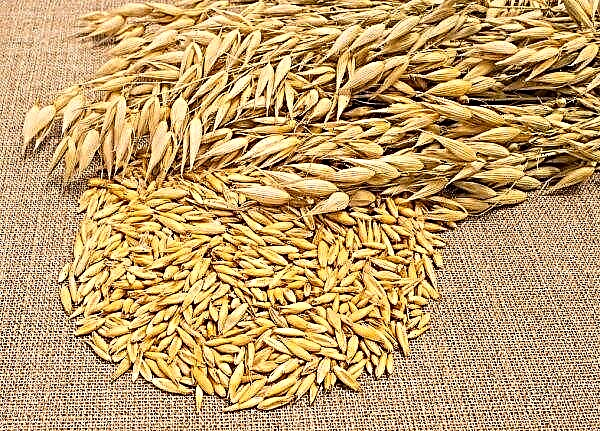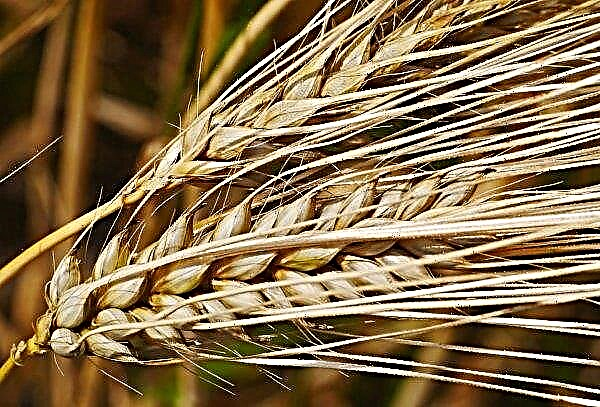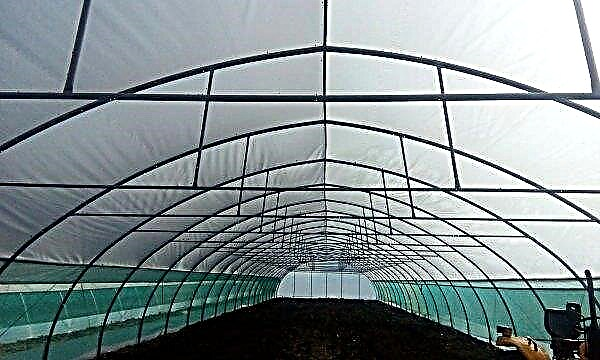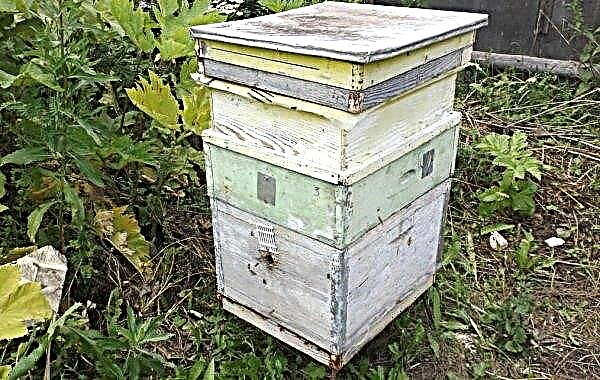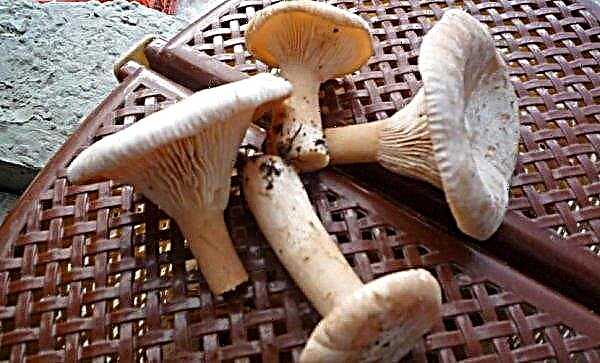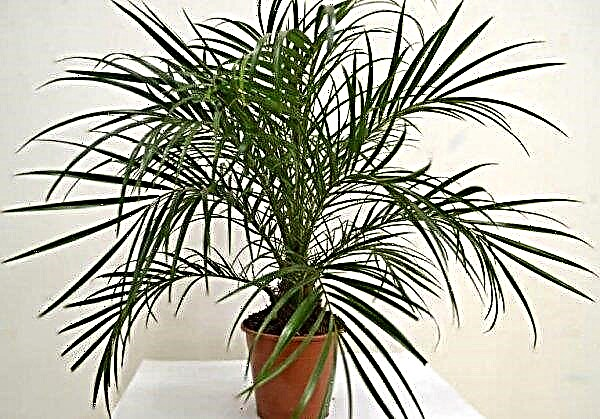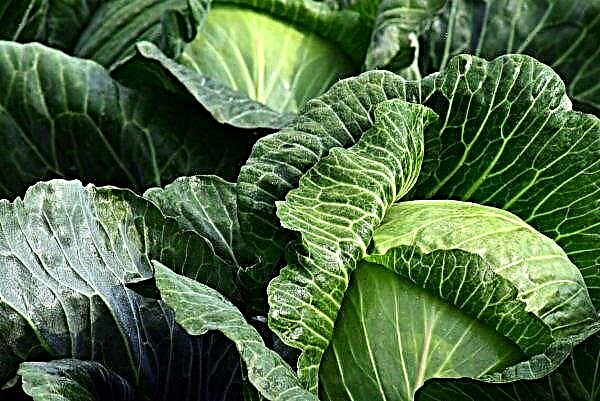Tradescantia has long been popular due to its unpretentiousness to growing conditions and beautiful, juicy greens. This herbaceous plant can often be seen in homes and in various institutions. In this article, we will focus on the cultivation of tradescantia zebrin, how to properly care for it, and how it can be propagated.
Botanical description of the plant
Tradescantia zebrina, in English-speaking countries it is usually called the "Eternal Jew", and in Russia, "Gossip Babies." The birthplace of this perennial tropical plant is the south of Mexico and Guatemala.
The height of the tradescantia does not exceed 15 cm, but the stems hanging down can grow up to 1.8 m. The flower has juicy stems with ovate lanceolate leaves located on both sides of the stem. The top surface of the leaf may be green to purple in color with two broad silver-white stripes. The lower surface of the leaves is painted in a uniform deep purple color. Leaves are pubescent along the edge with small villi.
Tradescantia zebrin is grown for foliage, not for beautiful flowering. Small pink or purple flowers may appear on the plant at any time of the year, although the most probable flowering time is late spring or early summer.
Important! Tradescantia is a slightly toxic plant for pets and humans. Although it is difficult for them to poison themselves, even if they eat a leaf, the juice of leaves and stems can cause contact dermatitis on the skin, especially in people with allergies or especially sensitive skin.
Purchase and adaptation
When choosing a tradescantia in a flower shop, you need to pay attention to the condition of the flower.
In a healthy plant:
- decorative appearance, thick and juicy leaves and stems;
- brightly colored leaves with a characteristic mottled pattern;
- no brown or wrinkled leaves;
- no long stems without leaves;
- all stems are healthy, they have no signs of rot.
In the store, carefully remember the place where the flower pot is located, and try to create similar conditions for it at home, especially in the first two weeks. Tradescantia adapts faster if you install the pot away from the battery or heating devices. The plant feels good in front of the window, at a distance of 2-3 m.
How to transplant after purchase
It is best to transplant a flower only once a year, in spring. Transplanting into a volumetric pot will give more room for growth of the root system, but if there is no possibility to transplant, the tradescantia will grow well in the same soil for several years.
For transplantation, the usual meadow meadow soil or birch soil is best suited, in which you can add a little well-rotted humus. Here is another successful composition of the soil mixture: two parts of leafy soil, to which one part of soddy soil, humus and coarse white river sand are added. You can also purchase ready-made soil in a horticultural center marked "for multi-colored plants."
If the tradescantia is bought in the spring, but does not feel well, perhaps it needs to be transplanted into new soil or a pot more quickly. It is possible to determine whether the pot is small for the plant by the roots that do not fit into the landing container. The volume of the pot should be such that the root system is located there freely, and between the roots and the wall of the container there is 2-5 cm of free space. This is necessary so that the flower can grow the root system without interference for several years, and get enough nutrients from the soil.
Important! A plant bought in the fall or winter, it is advisable not to disturb the transplant until spring.
How to transplant a zebrin:
- A pot made of plastic, ceramic, glass or metal is suitable for tradescantia.
- Holes must be present in the landing container to drain excess moisture after watering.
- Before planting at the bottom of the landing tank, it is necessary to lay a drain, which will not allow moisture to stagnate in the roots, which can cause root rot. Drainage can be made from fragments of thick branches, pieces of polystyrene or expanded clay.
- In order to pull an earthen lump with roots from a purchased pot: gently tap on the outer sides of the pot, then turn the flower over so that an earthen lump with roots extends to the hands of the grower.
- Next, the root system is shaken off the old soil, and the roots are inspected for rot. If there is one, the sore spot is carefully cut with the help of a garden pruner.
- A new pot is filled with soil by 1/3, after which a tradescantion is installed in the center so that the root neck of the flower does not appear to be recessed into the soil when planting, and is covered with earth.
- A planted flower is moderately watered so that the donkey soil. After that, if necessary, the words pour soil into the pot. The soil level should end 1 cm below the rim of the landing tank. This is important for easy watering.
- The transplanted plant is set for 3-5 days in partial shade to provide it with sparing conditions for adaptation.
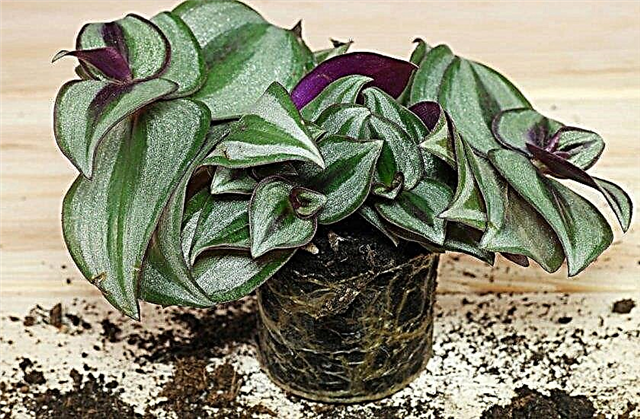
Prerequisites and proper care
In order for the tradescantia to please the owner with a lush bush and juicy, bright leaves, the plant must be given proper care: timely watering, top dressing, pruning, and a suitable air temperature and humidity.
Seat selection
For good growth, the zebrin needs a lot of light to keep the motley colors on the leaves, if the lighting is too dim, the leaves will become monophonic. But on the other hand, too bright sunlight provokes falling leaves on the flower. Usually this problem occurs in the summer. To protect the plant from thermal burns, just shade it.
Important! Being a tropical plant, the tradescantia does not like cold winds and drafts. Owners need to make sure that the flower pot is under the shelter of the side wall or any other obstacle to the draft.
Temperature and humidity
The leaves of the tradescantia are very juicy, so there is no need to worry too much about air humidity. Sometimes it’s worth moisturizing the leaves of a flower from a spray bottle, but if wrinkled or brown leaves appear on the tradescantia, air humidification must be stopped.
The plant does not tolerate subzero temperatures, and is absolutely not frost-resistant. In winter, the tradescantia feels great at room temperature +10 ... + 22 ° C. If the room temperature drops to +3 ... + 5 ° C, then the root system of the zebrina will not die, but the leaves will discolor, become whitish and ugly.
In the summer, the owners take the tradescantia to the loggia or to the patio of the courtyard, where the green cap of the zebrine becomes only more magnificent and brighter. In the warm season, the plant feels great at temperatures up to + 28 ° C, provided that bright sunlight is slightly muffled by higher neighboring plants, trees or a large summer umbrella.
Watering
During the rapid growth of the aerial part (spring and summer), the flower needs frequent and regular watering, which is reduced after the growth slows down or stops at all (late autumn, winter). At the same time, the tradescantia is very patient with periodic droughts or irrigation with a minimum amount of moisture.
It is best to water the flower under the root, or arrange a wick watering for the plant. To do this, a tow of woolen fabric is laid on the soil in the root zone of the plant, the second end of which is immersed in a container of water. This technique will always keep the potted soil in a slightly wet state.
A tropical plant can not be watered with ice water, before watering, the water is warmed to room temperature. It is advisable not to take chlorinated tap water to moisten the soil, or it is necessary to subject it to preliminary sedimentation for 2-3 days. The best option for irrigation water is rain or melt water.
Did you know? The stamens in the flowers of some varieties of Tradescantia are colored blue, but when exposed to ionizing radiation, such as gamma rays, the cells mutate and change the color of the stamens to pink. This is one of the plants that serves as an effective biological analyzer for radiation levels in the environment.
Top dressing
Variegated greens are fed with a solution of mineral fertilizers for indoor flowers. In the three summer months, when the green mass is rampant, feeding is carried out twice a month. Liquid fertilizer can be applied both on the sheet (by spraying) and under the root (by irrigation). In winter and autumn, top dressing completely stops.
Pruning
The growth rate of a tradescant is high if the room is warm and light. The natural position of the zebrina is drooping stems. If the flower is grown in a hanging basket, periodically too long stems must be shortened. If you want to grow a neat compact plant, then a short pruning should be carried out regularly.
Anti-aging pruning is also performed: once a month, brown leaves and dead stems are removed.
How to propagate
This unpretentious plant can be propagated in several ways: separation of the rhizome of the mother bush, cuttings or sowing seeds. We will understand a little more in detail with each method.
Cuttings
Tradescantia zebrin is very easy to propagate by dividing the aerial mass. To do this, long stems are cut with a sharp knife into segments 15-20 cm long, with several pairs of leaves on each. The stems prepared for propagation are set in a glass with water and any growth stimulant added, and left there until white roots appear on the bottom of the cuttings in the water. Root formation will take from 2 to 4 weeks. Rooted stems are planted in the soil. In one pot with a volume of 1 liter, you can plant 3-5 cuttings with roots.
Video: Cutting Zebraina Tradescantia
Dividing the bush
The method of rhizome division is the simplest method of propagating tradescantia. Usually this operation is carried out with a very overgrown bush.
How to split the tradescantia zebrin:
- Before removing the old bush from the pot, the walls of the container are gently tapped so that the soil lump is separated from the walls of the planting tank.
- The old bush is carefully removed from the pot, after which the roots are shaken off the old soil.
- The root system of the bush is carefully, but with force, divided by hands into two or three parts so that on each part (equally) there are green stems and roots. If you can’t separate the bushes with your hands, you can use a garden pruner.
- Separated new bushes are planted in separate planting tanks, and moderately watered after transplantation.

Seeds
Reproduction of tradescantia by seeds is the most time-consuming and time-consuming method. Usually it is used when they want to get absolutely healthy, virus-free planting material. Tradescantia seeds are very small, so they are sown in a container with compacted moist soil, on the surface of the soil. The landing container is covered with glass, which is raised once a day for half an hour for ventilation and watering.
Crops moisten with fine water dust from a spray bottle. Such irrigation is applied to emerging seedlings within a month. After the seedlings grow two pairs of true leaves, they are dived into separate planting tanks, and begin to water under the root (in the root zone).

Possible growing difficulties
When growing a tradescantia zebrina, the following problems may occur:
- Leaf fall. Usually caused by old plants, the oldest leaves turn yellow and fall for natural reasons. Sometimes the same symptoms are caused by excessive soil moisture.
- Loss of decorativeness. Caused by a lack of daylight, the leaves become almost a plain green color. By moving the flower pot to a well-lit part of the house, you can quickly return the plant to its former motley green color.
- Rotting of the stem. Tradescantia loves moist soil, but excessive and frequent watering ultimately causes stem rot. It is necessary to stop watering for a while, and then keep the soil slightly moist, but not wet.
- Naked, non-leafy stems. This problem arises in too old plants. The same symptoms, but on young bushes can appear with a catastrophic lack of light (at the same time the variegation of leaves disappears), or a constant lack of moisture in the soil (in addition yellow leaves will appear). Sometimes the cause of bare stems is the need for top dressing.

- Shriveled and brown leaves. Such symptoms can cause too dry air in the room, that is, a lack of humidity. In this case, you must either move the plant to another room, or moisten the air around the flower twice a day with a spray gun.
- Wilting, stunted growth. The cause may be the presence of a spider mite on the plant. It is difficult to see a very small pest, but its presence is reported by a thin, weightless web on leaves and stems. Against a spider mite, stalk treatment with insecticides is used. You can also wipe the stems and leaves on both sides with a sponge densely soaped with laundry soap.
Did you know? In Spain, the tradescantia is called the flower of St. Lucia (Santa Lucia), and the juice of the plant is used as eye drops to treat the eyes.
Healing properties
In folk medicine, tradescantia zebrin is used to treat various diseases:
- Infusion for colitis: 2 tablespoons of crushed mint leaves (dry or fresh) and 1 finely chopped zebrina leaf are mixed in a saucepan, after which they are poured into it with 0.6 l of boiling water, cover the container and leave for half an hour. The finished infusion is filtered through a strainer. Take the medicine three times a day for half an hour before meals, 100 ml.
- Decoction of flatulence: Mix 1 teaspoon of finely chopped zebrina tradescantia leaves with 1 teaspoon of pharmacy chamomile, pour into a saucepan. Pour vegetable raw materials with 2 cups of water and leave for an hour to insist, then put on fire and bring to a boil. The broth is boiled over low heat for 10 minutes. A strained broth is consumed three times a day 40 minutes before eating 0.5 teaspoon each.
- Lotion from corns. The leaves of the zebrina are soaked for 30 seconds in freshly boiled water, after which they are applied to corns (like a patch) and the lotion is fixed with an elastic bandage. After 3 hours, the lotion is removed, and new steamed leaves are immediately applied. After softening the corns, it is carefully removed.

Since ancient times, people attribute magical properties to this flower. For example, if there is one or several pots with tradescantia in the house, the evil person will feel uncomfortable in such a room, and will try to leave soon. An amazing plant protects its owners from defamatory rumors, gossip. Often the plant takes on host diseases, this can be determined by the suddenly drying and blackening stems.
A pot with a tradescantia will decorate a dwelling or courtyard with colorful, lush greenery. The flower needs proper care: watering, air temperature and humidity, timely top dressing.






